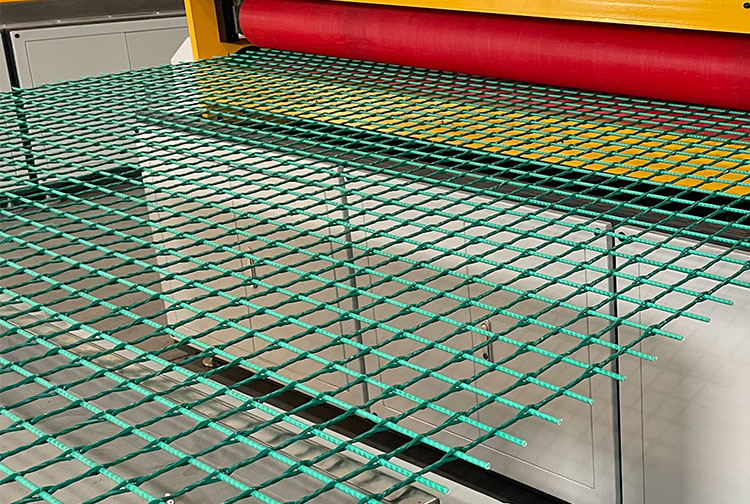The choice of reinforcement for concrete structures has far-reaching implications for the overall performance and longevity of a building. Traditionally, steel rebar has been the go-to option. However, in recent years, Glass Fiber Reinforced Polymer (GFRP) rebar mesh has emerged as a viable alternative, offering a unique set of properties that can be advantageous in specific applications.
Understanding GFRP Rebar Mesh
GFRP rebar mesh is a composite material made from glass fibers embedded in a polymer matrix. This combination results in a product that is lightweight, strong, and corrosion-resistant. Unlike steel, GFRP does not corrode when exposed to moisture or chemicals, making it an excellent choice for applications in harsh environments.
Key Differences Between GFRP and Steel Rebar
| Feature | GFRP Rebar Mesh | Steel Rebar |
| Corrosion Resistance | Highly resistant | Susceptible to corrosion |
| Weight | Lightweight | Heavy |
| Electrical Conductivity | Non-conductive | Conductive |
| Thermal Conductivity | Low | High |
| Cost | Generally higher upfront cost | Lower upfront cost |
| Tensile Strength | High tensile strength | High tensile strength |
| Modulus of Elasticity | Lower than steel | Higher than GFRP |
Advantages of GFRP Rebar Mesh
Corrosion Resistance: GFRP rebar is completely immune to corrosion, making it ideal for applications in marine environments, chemical plants, and infrastructure exposed to deicing salts.
Lightweight: The lightweight nature of GFRP reduces handling and transportation costs.
Non-Conductive: GFRP is non-conductive, making it suitable for applications where electrical conductivity is a concern, such as in proximity to electrical equipment.
Thermal Stability: GFRP has excellent thermal stability, making it resistant to thermal expansion and contraction.
Reduced Concrete Cracking: The lower modulus of elasticity of GFRP can help reduce cracking in concrete due to differential movement between the rebar and the concrete.
Disadvantages of GFRP Rebar Mesh
Higher Cost: GFRP rebar is generally more expensive than steel rebar.
Lower Modulus of Elasticity: The lower modulus of elasticity of GFRP means that it may not be suitable for applications requiring high stiffness, such as columns in tall buildings.
Limited Availability: GFRP rebar may not be as readily available as steel rebar in all regions.
Applications of GFRP Rebar Mesh
Marine Structures: Piers, docks, and offshore platforms
Chemical Plants: Tanks, pipes, and structures exposed to corrosive chemicals
Infrastructure: Bridges, parking garages, and roadways
Residential Construction: Foundations, slabs, and walls in coastal areas or corrosive soil conditions
When to Choose GFRP Rebar Mesh
Corrosion is a primary concern: If your project is located in a corrosive environment, GFRP rebar is an excellent choice.
Weight is a critical factor: For applications where weight reduction is important, GFRP is a lightweight alternative to steel.
Non-conductivity is required: If electrical conductivity is a concern, GFRP is a non-conductive option.
Reduced cracking is desired: GFRP can help reduce cracking in concrete due to its lower modulus of elasticity.
Conclusion
The choice between GFRP rebar mesh and steel rebar depends on a variety of factors, including the specific application, environmental conditions, and project requirements. While steel rebar remains a popular choice for many construction projects, GFRP rebar offers a compelling alternative in situations where corrosion resistance, lightweight, and non-conductivity are important considerations. By carefully evaluating the pros and cons of each material, engineers and contractors can make informed decisions to ensure the long-term performance and durability of their structures.
Additional Considerations
Bond Strength: The bond strength between GFRP rebar and concrete can be influenced by factors such as the surface profile of the rebar and the type of concrete mix.
Design Considerations: The design of concrete structures reinforced with GFRP requires specialized knowledge and may require adjustments to traditional design methods.
Cost-Benefit Analysis: A comprehensive cost-benefit analysis should be conducted to compare the long-term costs of GFRP and steel rebar, taking into account factors such as initial material cost, installation costs, and maintenance costs.
Future Trends
As technology continues to advance, we can expect to see further developments in GFRP rebar technology, leading to improved performance and reduced costs. Additionally, as environmental concerns become more pressing, the use of sustainable materials like GFRP is likely to increase in popularity.
By understanding the unique properties and applications of GFRP rebar mesh, engineers and contractors can make informed decisions to select the most suitable reinforcement material for their projects, ensuring the long-term performance and sustainability of their structures.
 +86 15303735673
+86 15303735673 Jessica@frpzs.com
Jessica@frpzs.com
 Technical Data
Technical Data












